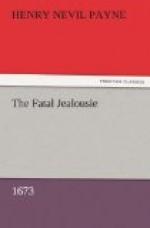With the deposition of James, the years of Payne’s greatest activity begin. The story of his life for the next twelve years is intricate and exciting, for he has now moved out of the company of writers into the dark world of secret agents and prison-guards. Though he was confined in the Fleet by January 1688/89, Payne went boldly ahead with plans for what would be the first Jacobite conspiracy, the Montgomery Plot. By some means he contrived to escape to Scotland, where his plans had, of course, more fertile soil in which to grow. Once more in custody, he was moved from one prison to another, but the Privy Council was incapable of persuading the Scottish authorities to “put the rogue to it.” As more and more evidence came out showing how deeply involved Payne was in the Montgomery Plot, the Scottish Privy Council finally was prevailed upon to put Payne to the torture. On Dec. 10, 1690, he bore the pain of two hours under thumb and leg screws with such fortitude that some of the Councilors were “brangled” and believed that his denials must be the words of an honest man. The Earl of Crawford, one of the witnesses to this, the last occasion in Britain in which a political prisoner was tortured, was so moved that he reported to the Earl of Melville that such manly resolution could come only from a deep religious fervor: “[Payne] did conceive he was acting a thing not only generous towards his friends and accomplices, but likewise so meritorious, that he would thereby save his soule, and be canoniz’d among the saints” (Letters ... to George Earl of Melville, Bannatyne Club, 1843, pp. 582-3).
For nearly eleven years more Payne was moved from one Scottish prison to another, while the Scottish Privy Council sought to turn him over to the English and the Privy Council in London endeavored to force him to trial in Scotland. The truth is that Jacobitism was so rife in high places that they whose duty it would be to prosecute him feared what might happen if he were brought to the bar.
Finally, in February 1700/01, Payne was released. He made his way to the Stuart court at St. Germain, whose incorruptible secret agent he had been for twelve years. It was fitting that the last information we have of him during his life is derived from his “Brief memorial by way of preface to some proposals for your Majesty’s service,” a detailed letter of advice instructing the exiled king how he might yet recapture his throne (printed in Original Papers; containing the Secret History of Great Britain, 1775, I, 602-5). When last heard from, Payne had yet another conspiracy planned and ripened, to submit to his sovereign’s approval.
Payne’s Fatal Jealousy has intrinsic merit. If he had written more works for the theater, he might have been remembered with Southerne and possibly with Otway. But for the scholar this tragedy will be chiefly interesting for the Shakespearean influences to be found in it. Evidently Payne held Shakespeare in great reverence, and the result is that The Fatal Jealousy is one of the earliest examples of the return to the Shakespearean norm in tragedy after the interlude of the heroic play. Payne ridicules the love and honor theme in The Morning Ramble where he makes Rose say (p. 54):




